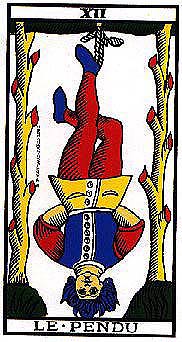|
|
The Hanged Man |
|
 If you've found this site useful, we'd really appreciate a small donation to help with the hosting costs. Thanks! |
Picasso was very conversant with the Tarot and seems to have identified closely with the card known as the Hanged Man. It depicts a man with his hands tied behind his back hanging by one of his feet from a gibbet placed between two trees.
The Hanged Man is in a state of solitude and submission to divine will, he hangs suspended between the forces of heaven and earth and his sacrifice brings him mystical knowledge and redemption.
The card corresponds astrologically with the sign of Scorpio, Picasso's birth sign, and its number is 12 which is related to inspiration and personal development.
In the 1934 drawing, whose composition is heavily derived from The Three Dancers, the central figure has one leg raised above the other upon the steps of a ladder. If imagined from the side, the figure's legs would have the same crossed appearance as the legs of the Hanged Man and those of the central figure in The Three Dancers.
This reveals a cryptic identification between the Hanged Man and the central figure in the 1934 drawing, who in turn is identifiable with Picasso. The origin of the Hanged Man is said to be connected with the sacrifice of Odin, the chief of the Norse gods, who according to mythology, hung upside down in a tree for nine days to gain entry to the underworld and learn the meaning of the runes. As a precondition to his self sacrifice Odin was wounded with his own spear and had to pull out one of his eyes. Picasso would have doubtless identified with the Odinic sacrifice and realised its obvious symbolic connections with Christ's crucifixion and with the 'crucified' exposure and self inflicted blindness of Oedipus. Odin according to myth, finally meets his end in a terrible apocalypse in which the universe is destroyed. The theme of the Odinic apocalypse, called Ragnorok, would have been well known to Picasso, not only because of his insatiable appetite for legends and myths, but also because it featured in the final act of Gotterdammerung, the Twilight of the Gods, the final part of Wagner's famous most famous operatic work, The Ring Cycle. In Wagner's version of the story, it is Odin who brings about Ragnorok because of his pride. Wagner signifies Ragnorok by the breaking of Odin's spear, the symbol of his power which equates symbolically with the spear in Parsifal and also with Picasso's name. Another important symbolic association between Odin and Picasso is that Odin's counterpart in the Southern pantheon is the god Hermes or Mercury. Picasso had been closely identified with Hermes from an early date, his friend Guillaume Apollinaire, openly referred to him as the Harlequin Trimegistus, a derived name of Hermes Trimegistus, Hermes the Thrice Great, the god of Alchemy.
© Mark Harris 1996 Alchemical ContextsNext Section: Interpretations of the 1934 Drawing |
|
|
|
     |
     |
|
|
© Mark Harris 1996 (content), Simon Banton 1996 (design) In general copyright of works by Pablo Picasso are the property of the heirs to the Pablo Picasso estate |
|

 Though interpretations of the card vary it is generally believed to symbolise a self-sacrifice in which the subject undergoes an important transformation from a materialistic consciousness to a spiritual consciousness.
Though interpretations of the card vary it is generally believed to symbolise a self-sacrifice in which the subject undergoes an important transformation from a materialistic consciousness to a spiritual consciousness.  The central figure in Picasso's Three Dancers features the outstretched arms of a traditional Crucifixion in combination with the crossed legs of the Hanged Man.
The central figure in Picasso's Three Dancers features the outstretched arms of a traditional Crucifixion in combination with the crossed legs of the Hanged Man.